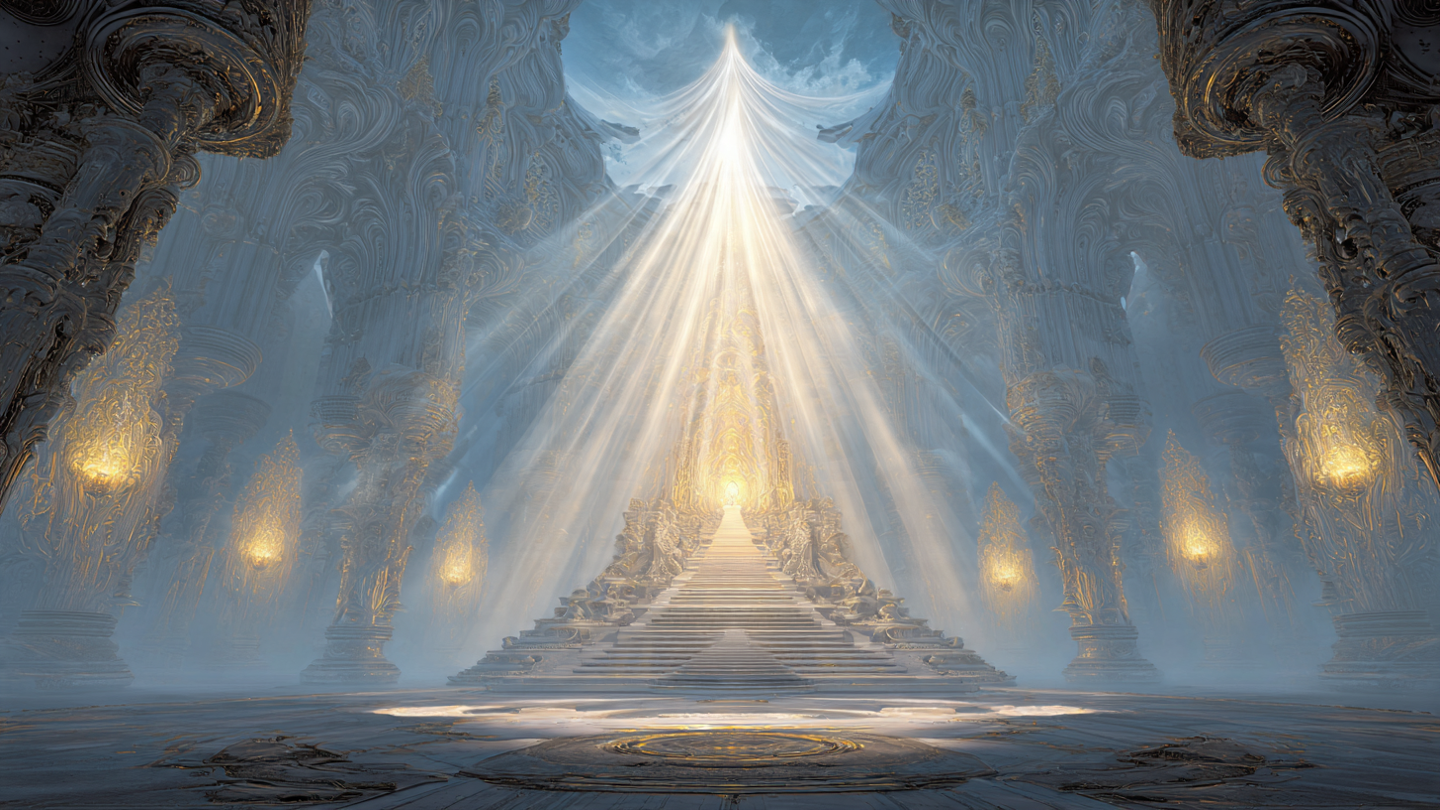Above the Throne: Quran and Hadith Reveal Divine Mysteries
In the name of Allah, the Most Gracious, the Most Merciful. Asalam o Alaikum. Today, we explore a realm beyond human comprehension—above Allah’s Throne, the greatest creation. The Quran describes the Throne’s vastness, with the Kursi, larger than the seven heavens, likened to a ring in a desert compared to it (Sahih Muslim 2788). Yet, the Throne dwarfs the Kursi similarly. This journey unveils the divine mysteries surrounding the Throne, its bearers, and the celestial beings nearby, stirring the heart with *Allah-u-Akbar*.
The Throne and Allah’s Istawa
The Quran mentions seven times that the Most Merciful is *Mustavi* above the Throne, as in Surah Taha (20:5). The term *Istawa* remains untranslated, a state beyond human understanding—neither standing nor sitting, but a divine condition surpassing all. No creature, not even the noblest angels, can approach this realm. Hazrat Zarrara ibn Abi Aufi (r.a.), a revered Tabi’i and student of Umar ibn Khattab (r.a.), narrates that Jibreel (a.s.) shuddered when asked if he had seen his Lord, saying veils separate him from Allah, and nearing them would burn him (Mustadrak al-Hakim).
Bearers of the Throne
The Throne is carried by four magnificent angels, described by the Prophet (PBUH) as resembling powerful mountain goats, with hooves-to-ears spanning centuries (Mustadrak al-Hakim). Named the Bearers of the Throne by Allah in Surah Ghafir (40:7), they glorify Him ceaselessly. On the Day of Judgment, eight angels will lift the Throne (Surah Al-Haqqa 69:17), a moment when all creatures will witness its descent.
The Muqarrabun: Angels Near the Throne
Besides the Bearers, the *Muqarrabun*—appointed angels—reside near the Throne, glorifying Allah day and night without tiring (Surah Ghafir 40:7, Surah Ha Mim As-Sajdah 41:38). Surah Al-Mutaffifin (83:18-21) describes their role in witnessing *Illiyin*, the highest record of the righteous, which Qatadah (r.a.), a renowned Tabi’i, identifies as a pillar of the Throne (Tafsir al-Tabari). These angels, mentioned in Surah An-Nisa (4:172), never weary of worship. The Prophet (PBUH) recited Surah Ha Mim As-Sajdah to Utbah bin Rabi’ah, moving him profoundly with its verses about these angels (Sahih Bukhari 4855).
Salam of the Muqarrabun
In a *Marfoo* Hadith, when Allah created Adam (a.s.), He commanded him to greet a group of angels, likely the *Muqarrabun*. Their reply, “Peace be upon you and the mercy of Allah,” established our greeting *Assalamu Alaikum wa Rahmatullah* (Sahih Bukhari 6227). Imagine Adam (a.s.) learning from these celestial beings, a scene evoking divine awe.
Glorification Near the Throne
The glorification around the Throne is unlike earthly *tasbeeh*. Nu’man ibn Bashir (r.a.) narrates that the Prophet (PBUH) described praises like *SubhanAllah* and *Alhamdulillah* revolving around the Throne, producing a buzzing sound like honeybees (Musnad Ahmad). This sound, also heard during the Prophet’s (PBUH) revelations or in pebbles glorifying Allah (Sahih Muslim 2277), holds profound secrets, as bees are uniquely spared from Hell (Surah An-Nahl 16:68-69).
Other Angels Near the Throne
The Angel of Death operates beneath the Throne, receiving names to claim souls without prior knowledge (narrated by Khusayma, r.a.). Ka’b al-Ahbar, a Jewish scholar who embraced Islam, describes an angel in Jannat al-Firdous crafting radiant jewelry for paradise’s dwellers, outshining the sun (Tafsir Ibn Kathir). Angels like Munkar and Nakir, with dark faces and blue eyes, or Ra’d, wielding a fiery whip to command clouds (Surah Ar-Ra’d 13:13), exhibit immense power. Hazrat Ali (r.a.) describes an angel with 70,000 heads, each with 70,000 mouths, tongues, and languages glorifying Allah (Tafsir Ibn Abi Hatim).
Ezekiel’s Vision and the Cherubim
Prophet Ezekiel (a.s.) saw the Throne’s bearers in a vision, described in the Book of Ezekiel (chapter 1) as four creatures with calf-like soles, moving like lightning, with wheels covered in living eyes. These *Keruvim* (Cherubim), akin to the Arabic *Muqarrabun*, reflect multidimensional sight, seeing all directions in higher realms, appearing distorted to human perception (Surah Al-Baqarah 2:243). This vision, alongside Ezekiel’s revival of the Valley of Dry Bones (Ezekiel 37), reveals divine signs.
Laylat al-Qadr and the Angels
On Laylat al-Qadr, Jibreel (a.s.) and angels descend from Sidrat al-Muntaha, observing worshippers (Surah Al-Qadr 97:4). A softened heart or goosebumps signal their presence. Reciting *La ilaha illallah* sincerely ensures forgiveness and paradise (narrated by Abu Ishaq, r.a.). Jibreel’s green wings dim the sun at dawn, a sign of this blessed night (Sahih Bukhari 2017). Angels report worshippers’ deeds, and Jibreel’s spontaneous *tasbeeh* for a repentant soul shakes the heavens, veils, and Throne with *Alhamdulillah* (Tafsir Ibn Abi Hatim).
The Day of Judgment: The Throne Descends
On the Day of Judgment, a piercing trumpet will sound, and the sky will open with doors—portals or wormholes—revealing the Throne (Surah An-Naba 78:18-19). Ibn Abbas (r.a.) explains tunnels stretching across the heavens, through which angels and the Throne descend (Surah Al-Baqarah 2:210). Veils of light and darkness, with a terrifying water-like sound, will separate creation from the Throne (narrated by Abdullah ibn Amro, r.a.). All creatures will faint, with the Prophet (PBUH) first to awaken, seeing Moses (a.s.) clinging to the Throne’s leg (Sahih Bukhari 7517). Eventually, only Allah remains, proclaiming His sole sovereignty before reviving creation with rain from Bahr al-Masjoor (Sahih Bukhari 6528).
Conclusion
Above the Throne lies a realm beyond comprehension, where Allah is *Mustavi*. Surrounded by the Bearers, *Muqarrabun*, and other angels, the Throne’s glorification echoes like bees buzzing. From Ezekiel’s vision to Laylat al-Qadr, these divine mysteries evoke *Allah-u-Akbar*, urging us to reflect on Allah’s infinite greatness.
Source Credit
This article is inspired by the video “Quran Reveals Mysteries Above the Throne” on Furqan Qureshi Blogs. Watch it here: Watch Now.

